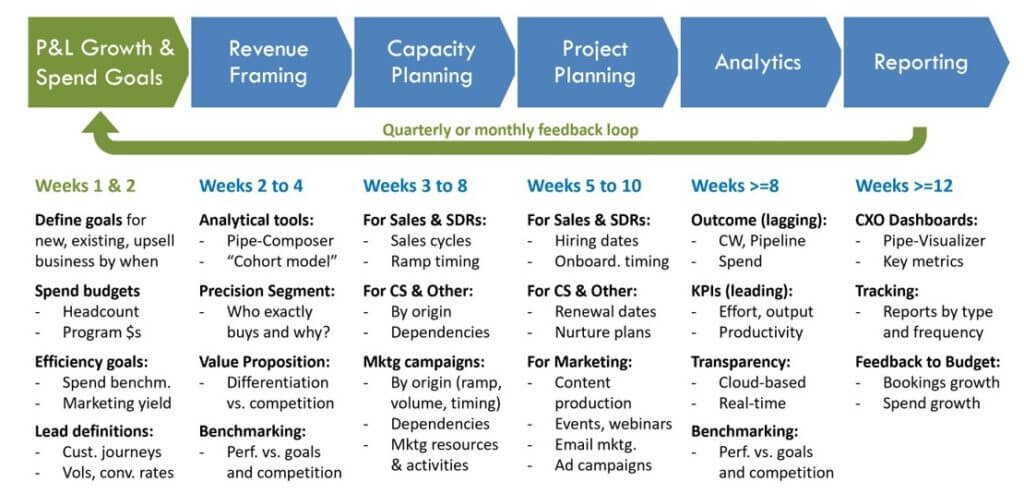What is Growth Architecting and Why Should I Care?
You probably never heard of “Growth Architecting,” and so you may be reading this thinking, here we go, yet another concept or acronym, and probably don’t know if you should care. We do think you should care, and let us explain why: Growth Architecting is shorthand for the integrated set of planning and monitoring techniques and tools needed to answer this core question every CEO asks: “How much pipeline do we need by when from which sources to make our bookings goals in quarter X / year Y?”
It sounds like a commonsensical and too simple question to ask. Still, in our experience, it’s the minority of startups that don’t struggle with quantifying that answer from all their various sources of the pipeline into one, smoothly and harmoniously integrated response. One common issue that is often overlooked (especially in cloud businesses) is the mix between new business, upsell/cross-sell, and renewals. Very important for the revenue-generating teams to have an aligned vision of how bookings are to be generated, and which team has to provide how much of the total.
However, in many cases, there instead is siloed thinking between sales, customer success, and marketing. In other cases, there may be a system of cascading spreadsheets, but it’s too complex to comprehend, let alone use to model the impact of needed strategic course corrections quickly. Or, on the opposite end of the maturity scale, the approach to pipeline generation is simplistic, leaving it all up to sales reps or sales development reps (“SDRs”) to cold call their way into the new pipeline, with the resulting low closure rates, low efficiency, and little forward-looking visibility.
Most companies do it one of these ways, so what’s the problem?
Whether the inhibitors to a coordinated, structured approach to pipeline generation, which is what we mean by “Growth Architecting,” are rooted in cultural/emotional issues, in insufficient analytical skill in the organization to model sophisticated pipeline generation, or come from one-sided thinking such as staffing a simple cold-calling process only, the costs are high: It takes too much effort to plan growth (i.e., future bookings), the results are imprecise and inaccurate, and the whole system is slow and lacks the flexibility to rapidly adapt to needed changes in strategy or tactics.
Second, investors pay a premium for predictable bookings growth and profitability and, thus, by extension, for efficiency and accurate pipeline forecasting. Yet, most startups cannot accurately quantify the answer to the above CEO question: “How much pipeline do we need by when from which sources to make our bookings goals in quarter X / year Y?”. So, between inefficiency and conflict potentially, and sub-optimal valuations from investors, not knowing how to architect and track a startup’s growth can become expensive and time-consuming.
If a lot of effort and precision went into researching the underlying forecasts, then the goals are realistic and hopefully can be met. If that didn’t happen, it is common that these plans get revised on a quarterly or more frequent basis. Add some politics to it, and the process can draw out to weeks or months, all the while the business is flying blind. At one engagement, there had to be 13 budget revisions in Q4 as a result of fluctuating forecasts, wasting untold hours, and Q1 growth goals took three months to set.
How do I use this structured, integrated approach to architecting growth?
The typical approach of cascading spreadsheets starts with a CFO-maintained booking and cashflow model for the company that sets the quarterly or monthly bookings, growth, and profitability goals. Then s/he breaks all that down into department goals, either through a consensus process or by a directive, and then the various departments go off and build their plans. Once those are built, everyone comes back and makes sure they’re aligned – the revenue goals need to be aligned with manufacturing’s production goals, or the growth goals are synched up with marketing’s pipeline goals, and so on.
Quantify answers to six key, C-level questions
At a high level, a well-done growth architecture should be able to quantify answers to these questions:
- How much pipeline do we need by when from which sources to make our bookings goals in quarter X / year Y?
- How do we optimally allocate budgets across all our pipeline sources (i.e., sales, SDRs, partners, marketing, and referrals/customer success)?
- How do we model different strategies and scenarios?
- How much will that cost as % of pipeline and bookings?
- How does our pipeline yield compare to our competitors and industry benchmarks?
- Is our pipeline and revenue acquisition on a plan?
In subsequent blogs, we’ll go more deeply into the required analytics and algorithms to quantifying the answers to these five questions. In some cases, like the benchmarking questions nos. 4 and 5, external research and data will also be required for similar businesses.
Launch an integrated planning process across all functions and implementation phases
To answer these fundamental questions and to also build the ongoing infrastructure and processes to answer these questions in real-time as startups scale, requires going through what we call a “maturation flow,” the integrated planning and tracking tools and processes we refer to as “Growth Architecting”:
- From the P&L forecast, set growth and spend goals and break down by department.
- Plan lead requirements by the department and set goals via bottom-up lead production model.
- The plan needed capacity:
- Bottom-up demand generation plan
- SDR / sales rep capacity planning
- SDR and sales productivity and velocity
- Do sales reps have the required skills?
- Marketing campaign and content planning
- Do we have a product people want?
- Do we have impactful content?
- What is our brand’s benefit?
- Customer success renewal planning
- Do we have enough capacity to handle all upcoming renewals?
- Assemble project plans to support campaigns:
- Marketing campaign calendar
- Content planning (topics and artifacts)
- Existing customer nurturing campaigns
- Ongoing analytics and data-driven optimization
- OKR / KPI tools
- Budget planning and ROI tracking, both top-down and bottom-up (i.e., by dept and initiative)
In figure 1, you can see a complete version of the Growth Architecting process as a flowchart. To manage expectations, to implement this entire process at scale, have team members trained, tools developed, etc., can take a year. While that seems a lot, the payback in terms of the saved workforce from continuing to do ah-hoc, manual processes, side-stepping everyday turf battles, and the efficiencies arising from focusing spend on high yield initiatives is more than worth the effort. Not to mention happier investors and a C-Suite that knows where their business is going and how fast.

Disagree with our theses? Please send us your comments.
In the meantime, for some further reading, here are links to some useful articles that further elaborate what investors are looking for beyond just growth but also around predictability:








